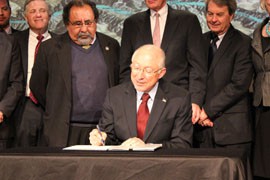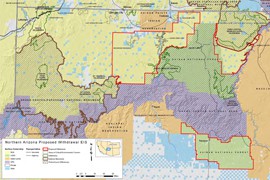Cronkite News has moved to a new home at cronkitenews.azpbs.org. Use this site to search archives from 2011 to May 2015. You can search the new site for current stories.
Government imposes 20-year ban on new mining claims near Grand Canyon
WASHINGTON - Interior Secretary Ken Salazar ordered a 20-year ban Monday on new mining claims on more than 1 million acres near the Grand Canyon, a move he said will protect a place Americans “love and care for.”
The move, which will primarily affect uranium mining in the region, was a victory for environmentalists who fought for two years to prevent further mining in the so-called Arizona Strip in the northern part of the state.
It was immediately attacked by state and federal lawmakers who called it a blow to job creation “fueled by an emotional public relations campaign.”
“The Obama administration’s decision will cost Arizonans more high-paying jobs under the false pretense of ‘protecting’ one of our national treasures, the Grand Canyon,” said Sen. John McCain, R-Ariz., in a prepared statement.
Bills introduced by McCain and a majority of the state’s congressional delegation in October could block a mining ban in the Arizona Strip. The Northern Arizona Mining Continuity Act of 2011 is pending in both the House and Senate.
But Salazar said the ban was the right choice in order to protect important environmental and cultural resources for future generations.
“We are carrying forward that uniquely democratic and uniquely American tradition of protecting the places that we love and care for, for all Americans,” Salazar said at a signing ceremony at the National Geographic building in Washington.
The ban will remove more than 1 million acres of federal land within the Mohave and Coconino counties from new hard-rock mining projects.
It will not affect current mining operations or those that had previously won approval to mine. As many as 11 more uranium mines could be developed based on pre-existing rights, according to the Department of the Interior.
Already there are about 3,200 mining claims in the area, and the ban will also continue to allow other natural resource development in the area.
“There is only one Grand Canyon,” said Harris Sherman, Agriculture undersecretary for Natural Resources and Environment. “We must err on the side of caution, and this decision will strongly protect water, wildlife and cultural resources.”
Salazar temporarily halted new mining claims near the canyon in 2009, giving the Bureau of Land Management two years to study the effects of mining on the area and determine whether a longer ban was needed. That study resulted in an environmental impact statement, released in October, recommending the 20-year ban.
Rep. Raul Grijalva, D-Tucson, said the ban sets a precedent, balancing conservation with development.
“The caution that the secretary showed today is necessary,” Grijalva said. “It sets a template for protection.”
But critics say mining would not pose the threat to the Grand Canyon that the government fears.
“Uranium mining in northern Arizona occurs well outside Grand Canyon National Park,” said Rep. Jeff Flake, R-Mesa, in a prepared statement. “So if I believed that uranium mining in parts of northern Arizona posed a threat to the Canyon, I would not support it.”
Opponents of a ban also point to the potential economic boon from uranium mining. The area affected by the ban could have as many as 165,000 tons of uranium, worth $17.16 billion at today’s prices, said Gregory Yount, manager of the Northern Arizona Uranium Project, a uranium exploration company.
Gov. Jan Brewer expressed her disappointment in the ban, saying in a statement that it could cost Arizonans hundreds of jobs and about $10 billion for the economy.
But Salazar and others point to the economic benefit of the Grand Canyon itself, saying tourism brings in $3.5 billion a year for the region’s economy and that its conservation is vital.
“It’s an important decision environmentally, ecologically as a legacy to future generations, and it’s important from an economic perspective,” said Sandy Bahr, director of the Sierra Club’s Grand Canyon chapter. “This is a decision that promotes something that is sustainable.”











